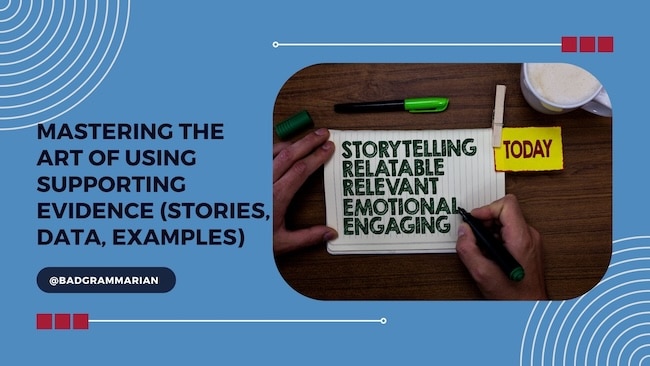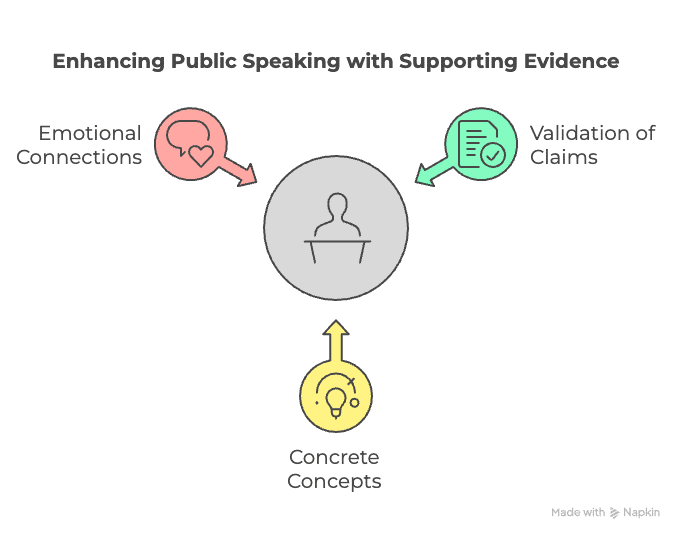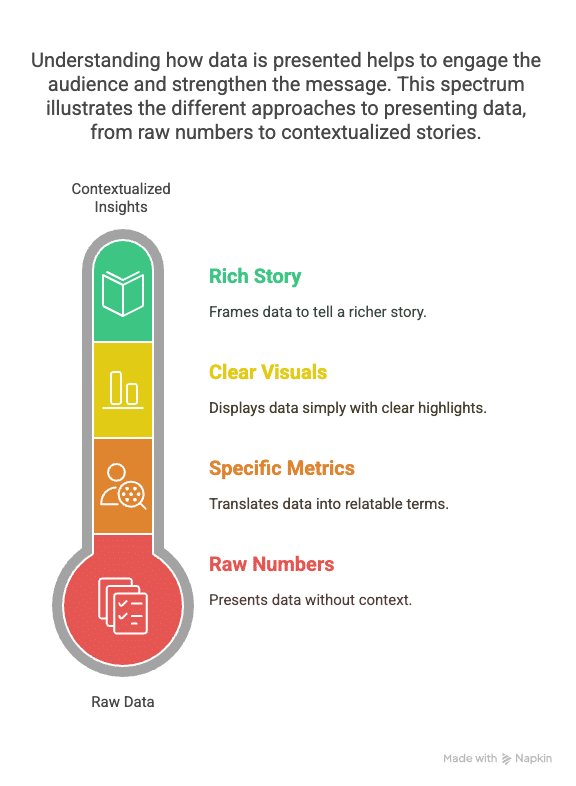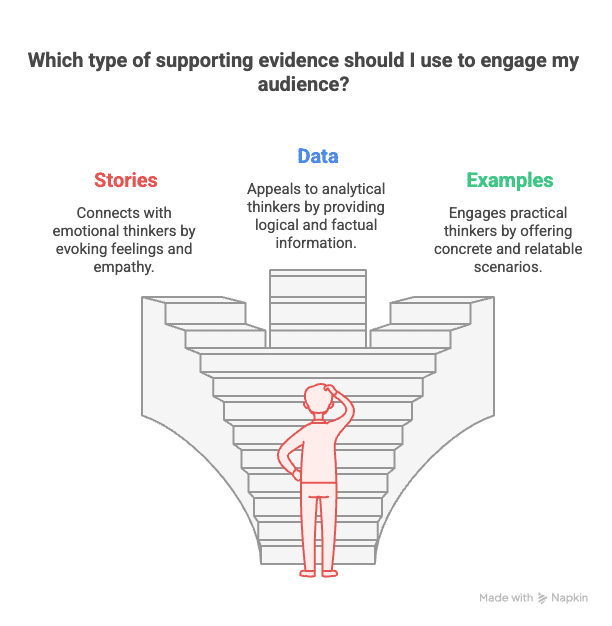Best Noise-Canceling Headphones for Writers: Enhance Focus and Creativity
Mastering the Art of Using Supporting Evidence (Stories, Data, Examples)

Have you ever sat through a presentation that felt like a series of empty claims? Statements without substance that left you thinking, “Says who?” or “Prove it!” As speakers, we often have brilliant ideas we want to share, but without proper support, they're just opinions floating in the air.
In this guide, we'll explore how using supporting evidence (stories, data, examples) can transform your presentations from forgettable monologues into compelling, persuasive experiences that resonate with your audience long after you've left the stage.
Why Supporting Evidence Matters in Public Speaking
When you make a claim in your presentation, your audience's natural reaction is skepticism. The audience is thinking, “Why should I believe you?” This is where supporting evidence comes in, as the foundation for building credibility and trust.
According to communication experts, supporting evidence serves three crucial functions:
- Validates your claims – Provides proof that what you're saying has merit
- Makes abstract concepts concrete – Turns theoretical ideas into tangible understanding
- Creates emotional connections – Helps your audience relate to and remember your message

As Toastmasters International emphasizes in its training manuals, carefully supporting your points and opinions with specific facts, examples, and illustrations gathered through research isn't just helpful—it's essential for effective communication.
The Power of Stories as Supporting Evidence
Stories are perhaps the most potent form of supporting evidence. They're not just entertaining anecdotes but psychological tools that fundamentally change how your audience processes information.
Communication expert Carmine Gallo notes that stories help listeners become emotionally attached to your topic and can actually “sync” minds with your audience, creating deeper connections. Stories are powerful tools for persuading customers, employees, and investors because they tap into how humans are wired to learn and connect.
How to Use Stories Effectively:
- Find the story in everything – Whether you're talking about a product feature or a business strategy, there's always a human story that can illuminate its value. Read our post on mastering the art of storytelling.
- Include a mix of story types:
- Personal stories that reveal your character and authenticity
- Stories about others that demonstrate your message in action
- Brand success stories that showcase real-world impact
- Build proper tension – A good story has a beginning that sets the scene, a middle that creates tension or presents a challenge, and an end that provides resolution.
- Add an anecdote early – Including a brief personal story near the beginning of your presentation humanizes you and creates an immediate connection with your audience.

As presentation design expert Nancy Duarte explains in her book “Resonate,” transforming information into stories makes your content more dramatic and experiential, creating a lasting impact that raw information alone cannot achieve.
Leveraging Data and Statistics as Compelling Evidence
While stories appeal to emotions, data appeals to logic, and the most persuasive presentations engage both. However, not all data presentations are created equally. Simply throwing numbers at your audience can be as ineffective as having no data at all.
When using data as supporting evidence, remember these principles:
Make Numbers Meaningful:
Presentation expert Carmine Gallo observes that Steve Jobs never just presented raw numbers. Instead, he made them specific, relevant, and contextual. For example, Jobs would translate this into “1,000 songs in your pocket”—a far more meaningful and memorable metric for consumers than just stating storage capacity in gigabytes.
Present Data Visually:
Nancy Duarte advises in “Slideology” that you should only show data if it helps illustrate your conclusions, and when you do, display it clearly. Use contrast to highlight what's important and keep data slides simple to ensure your audience can easily absorb the information.
Provide Context:
Numbers in isolation rarely persuade. Always frame your data within the context of what it means for your audience. As Gallo emphasizes, successful information design with statistics can tell a richer story when properly contextualized.

Strengthening Your Message with Examples and Illustrations
Examples and illustrations clarify and reinforce your points, making abstract concepts more concrete and understandable. They bridge the gap between complex ideas and practical understanding.
Types of Examples to Consider:
- Demonstrations – Showing rather than telling how something works
- Case studies – Detailed analyses of specific instances that prove your point
- Analogies and metaphors – Comparisons that make the unfamiliar familiar
Steve Jobs was a master of using metaphors as rhetorical devices to make his narratives more engaging. His famous comparison of a computer to a “bicycle for the mind” transformed a technical product into an inspiring tool for human potential.
Practical Tips for Using Examples:
- Be specific – Vague examples undermine your credibility
- Be relevant – Choose examples your audience can relate to
- Be concise – Include enough detail to be clear, but avoid extraneous information
Creating a Balanced Approach to Supporting Evidence
The most effective presentations use a strategic mix of stories, data, and examples. Gallo introduces the concept of a “message map,” which reinforces a headline with three key messages, each supported by stories, statistics, and examples.
This balanced approach addresses different learning styles and thinking preferences in your audience:
- Emotional thinkers connect with stories
- Analytical thinkers respond to data
- Practical thinkers appreciate concrete examples

The “rule of three” applies here as well—the human mind best processes information in groups of three, making this an optimal structure for organizing your supporting evidence.
How to Research and Gather Strong Supporting Evidence
Developing compelling presentations requires a system for collecting and organizing supporting evidence. Leadership expert John Maxwell reveals that he continuously gathers stories, quotes, thoughts, ideas, and illustrations to support his speaking themes.
Maxwell's Method:
- Continuously collect – Always look for great material that fits your values and style.
- Create a filing system – Organize your evidence by topic for easy retrieval.
- Connect to your message – Select only evidence that directly supports your thesis.
The Toastmasters manual recommends starting research with your existing knowledge and then filling in gaps using various sources, such as the Internet, libraries, and expert interviews. Always record information and its source for future reference and credibility.
Adapting Your Evidence to Your Audience
The most compelling evidence is audience-specific. What resonates with one group might fall flat with another. Before selecting your supporting evidence, consider:
- Knowledge level – What background information does your audience already have?
- Values and priorities – What matters most to this particular audience?
- Cultural context – Are there cultural references or examples that will particularly resonate?
The difference between what is known and unknown for your audience is vital in determining the most effective supporting evidence.
Conclusion: Elevate Your Speaking with Strategic Supporting Evidence
Using supporting evidence (stories, data, examples) isn't just about backing up your claims—it's about creating a rich, multi-dimensional presentation that engages your audience intellectually and emotionally.
When you master the art of supporting your ideas with the right mix of evidence, you transform from someone with opinions to someone with authority. Your messages become more persuasive, your impact more lasting, and your reputation as a speaker significantly enhanced.
Remember that passion is linked to compelling storytelling. If you're genuinely passionate about your supporting evidence, it will naturally become more captivating to your audience.
Your Next Steps:
- Audit your next presentation draft – Does each main point have strong supporting evidence?
- Create a personal collection system – Gather stories, data points, and examples related to your typical speaking topics.
- Practice translating data into meaningful stories – Take a statistic and find the human story behind it.
- Join a speaking group like Toastmasters – Get feedback on how effectively you use supporting evidence.
What supporting evidence do you find most persuasive in the presentations you watch? Share your thoughts in the comments below.
Check out our top books on public speaking and our list of the best online courses on public speaking available!
Yes! I want Bad Grammarian updates and promotions!
No Spam Zone. We will never spam or sell your email address!
Yes! I want Bad Grammarian updates and promotions!
No Spam Zone. We will never spam or sell your email address!


